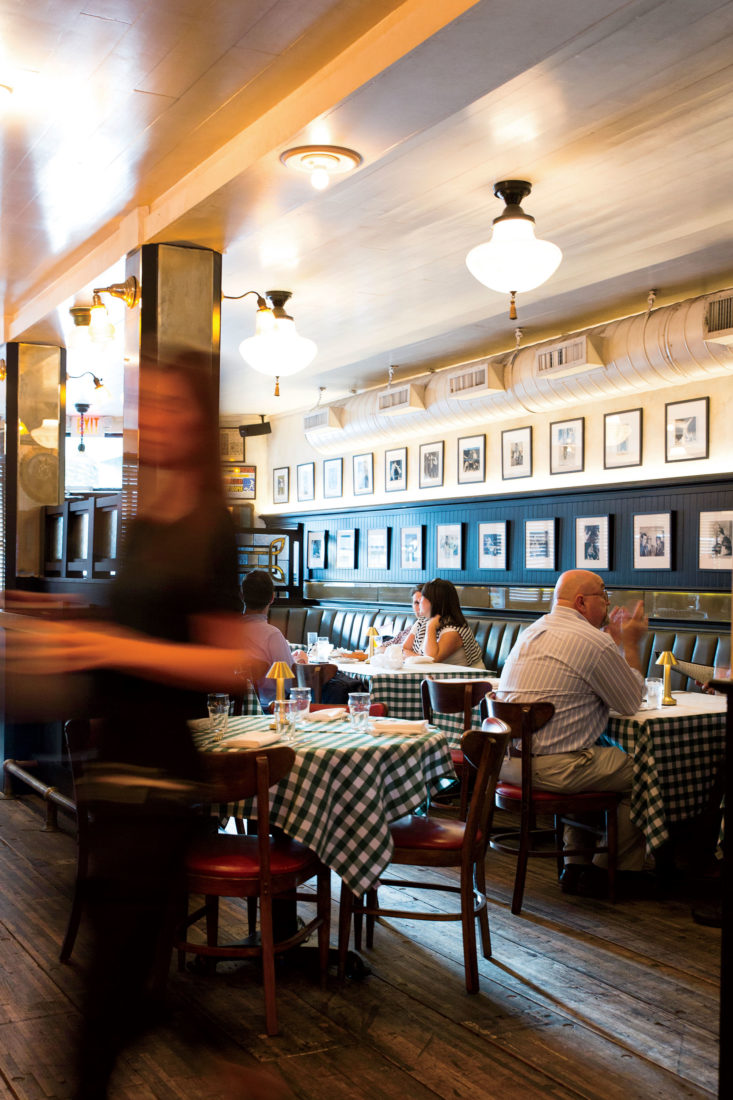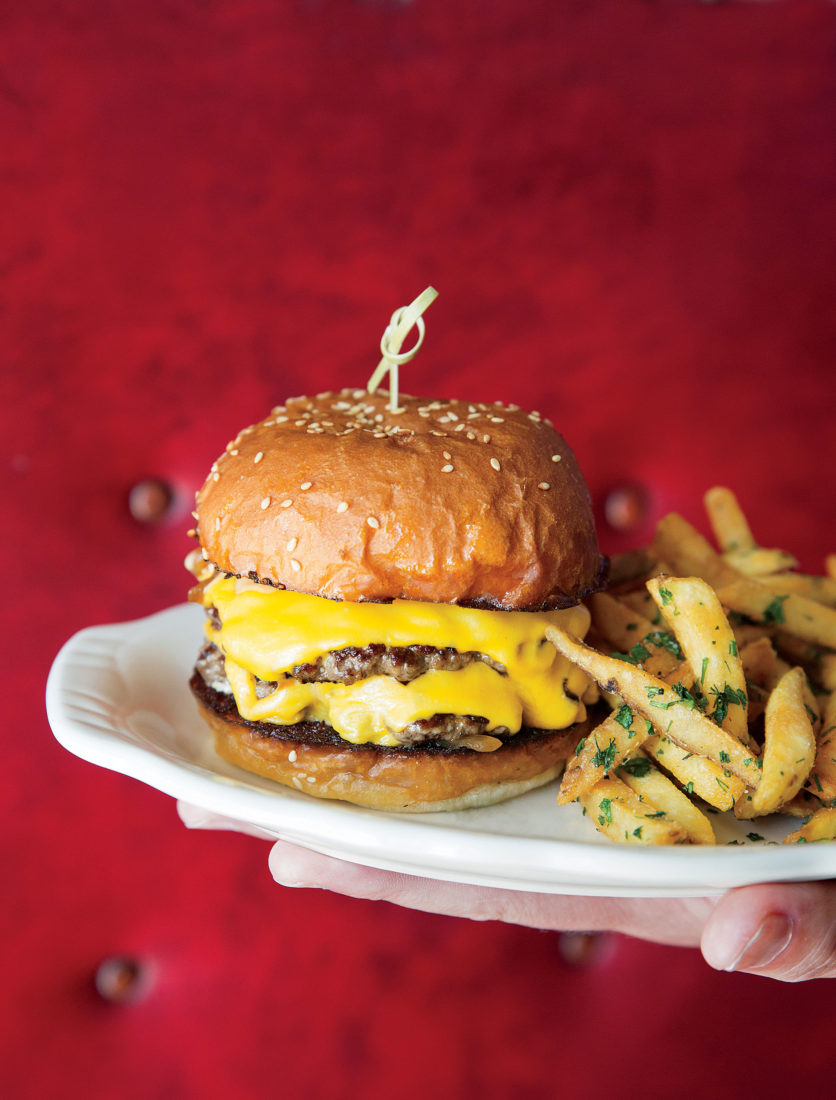Three generations claimed a corner booth, set against a louver-shaded window bank, at Little Jack’s Tavern in Charleston, South Carolina. They had moved to dessert when I began stealing glances. Grandmother, hair teased into a gray corona, ordered a brownie in a trifle glass. Father toyed with the terrier-shaped ceramic salt and pepper shakers, whispered in the ear of Mother, and chose an amaretto sour.
Surveying the letter-board dessert menu posted to the back wall, noting the beautifully absurd possibility advertised there, the teenage son with the mop of black hair ordered a Tavern burger. When the griddle-crusted blend of chuck and brisket arrived, tucked in a compact sesame seed bun, the family burst into laughter.
Ten years from now, that family won’t recall who ate the brick-cooked chicken, with its crackly skin and garlicky flesh. Ditto the cracked crab, lying in icy repose. Or the shrimp cocktail, sharp with freshly grated horseradish. They might not even remember the place’s name. What that family will recall is how they laughed uproariously in a mod steak house that advertised a burger as a dessert.

Photo: Margaret Houston
Proprietor Brooks Reitz.
Open since 2016, Little Jack’s, owned by Brooks Reitz and his business partner Tim Mink, hunkers on the upper reaches of King Street, where gentrification abuts reality. Leon’s Fine Poultry & Oyster Shop, also owned by Reitz and Mink, is a neighbor. With its poured-concrete floors and glass garage doors, Leon’s was recently a body shop. Little Jack’s, now a low-ceilinged send-up of a midcentury supper club, flocked with black and whites of boxers pacing the ring and harness racers circling the track and lit by a constellation of pendant fixtures, had been a windowless storage office.
Smart design made those restaurants. Keen menu choices complemented the furnishings. Personal narratives grounded the enterprise. As a boy, Reitz joined his grandmother Mimi Huber for steak dinners at the Kennel Club of Evansville, in Indiana, across the Ohio River from his hometown of Henderson, Kentucky. Reitz escorted a high-school homecoming date to that same jacket-required restaurant. The portraits of dogs that lined the walls, as early as 1925, inspired those salt and pepper shakers. The club’s shaken martini inspired Little Jack’s house cocktail.
Architects call this design exercise placemaking. Small cues, embedded in furniture, china, glassware, and music, accrete. They layer to fashion a story. Take that burger: The menu board, a utilitarian diner throwback, advertises it as dessert. That placement signals that Little Jack’s rejects convention and abets pleasure. When the burger arrives, garnished with sunchoke relish, draped with American cheese, it completes the narrative.
Reitz catalogues and curates details, drawing on childhood recollections and travels across the nation and world. To prosecute his vision, he assembled a team of fabulists and fabricators, from painters who specialize in trompe l’oeil to electricians expert at rewiring junked Victorian sconces. He sources dishes just as artfully. Properly charred hanger steaks, borrowed from the French brasserie playbook, sliced and stacked like dominoes, arrive alongside butter-glossed eddies of pureed potatoes. Chef John Amato’s egg in celery root cream appetizer, pocked with green peas and threaded with prosciutto, tastes, in the best way, like a Stouffer’s TV dinner that got upgraded from coach to first class. You recognize the form. Then you marvel at the playful reinvention.
To play the blues you have to “mispronounce the right words correctly,” wrote Albert Murray, the novelist and critic. That describes good restaurant design, too. To earn their spaces a patina, keen restaurateurs scuff and ring tabletops and bars. They mismatch china. They purposefully tarnish mirrors. Done correctly, the look showcases the interplay of place and people over time.

Photo: Margaret Houston
The dining room at Little Jack’s.
To develop Little Jack’s, Reitz followed the path of Keith McNally, the New York City restaurateur who imagined the restaurant Pastis as a Parisian boîte. McNally asked: What would the space look and feel like if, instead of creating it anew, he had been the second or third owner to walk the floor? Reitz worked a similar query in his head, piecing together the story of Little Jack, a diminutive boxer who punched up.
After suffering one too many defeats, Jack turned to the tavern business. The second-generation owner, a devout Catholic, mounted portraits of John F. Kennedy on the wall and added a kitchen. The current proprietor, a grandson of Little Jack’s, now bets on the racehorses and stirs top-shelf cocktails. More than a fiction coined to entertain customers, that narrative offers Reitz a means to manage his aesthetic.
With Little Jack’s, Reitz and Mink realized something I’m recently willing to admit: Feel is more important than food. Once the food in a restaurant meets a certain level of excellence, the way you feel is what matters. For smart consumers with well-educated palates, that queers our empirical tendency to measure excellence on a dish-by-dish scale. A night at Little Jack’s gives you reason to suspend disbelief. Succumb to the narrative, relish the food, revel in the feel. Order a burger for dessert.








